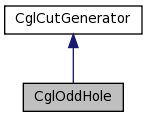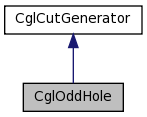CglOddHole Class Reference
Odd Hole Cut Generator Class. More...
#include <CglOddHole.hpp>


Public Member Functions | |
Generate Cuts | |
| virtual void | generateCuts (const OsiSolverInterface &si, OsiCuts &cs, const CglTreeInfo info=CglTreeInfo()) const |
| Generate odd hole cuts for the model of the solver interface, si. | |
Create Row List | |
| void | createRowList (const OsiSolverInterface &si, const int *possible=NULL) |
| Create a list of rows which might yield cuts this is to speed up process The possible parameter is a list to cut down search. | |
| void | createRowList (int numberRows, const int *whichRow) |
| This version passes in a list - 1 marks possible. | |
Create Clique List | |
| void | createCliqueList (int numberCliques, const int *cliqueStart, const int *cliqueMember) |
| Create a list of extra row cliques which may not be in matrix At present these are classical cliques. | |
Number Possibilities | |
| int | numberPossible () |
| Returns how many rows might give odd hole cuts. | |
Gets and Sets | |
| double | getMinimumViolation () const |
| Minimum violation. | |
| void | setMinimumViolation (double value) |
| Minimum violation. | |
| double | getMinimumViolationPer () const |
| Minimum violation per entry. | |
| void | setMinimumViolationPer (double value) |
| Minimum violation. | |
| int | getMaximumEntries () const |
| Maximum number of entries in a cut. | |
| void | setMaximumEntries (int value) |
| Minimum violation. | |
Constructors and destructors | |
| CglOddHole () | |
| Default constructor. | |
| CglOddHole (const CglOddHole &) | |
| Copy constructor. | |
| virtual CglCutGenerator * | clone () const |
| Clone. | |
| CglOddHole & | operator= (const CglOddHole &rhs) |
| Assignment operator. | |
| virtual | ~CglOddHole () |
| Destructor. | |
| virtual void | refreshSolver (OsiSolverInterface *solver) |
| This can be used to refresh any inforamtion. | |
Private Member Functions | |
Private methods | |
| void | generateCuts (const OsiRowCutDebugger *debugger, const CoinPackedMatrix &rowCopy, const double *solution, const double *dj, OsiCuts &cs, const int *suitableRow, const int *fixedColumn, const CglTreeInfo info, bool packed) |
| Generate cuts from matrix copy and solution If packed true then <=1 rows, otherwise >=1 rows. | |
Private Attributes | |
Private member data | |
| int * | suitableRows_ |
| list of suitableRows | |
| int * | startClique_ |
| start of each clique | |
| int * | member_ |
| clique members | |
| double | epsilon_ |
| epsilon | |
| double | onetol_ |
| 1-epsilon | |
| double | minimumViolation_ |
| Minimum violation. | |
| double | minimumViolationPer_ |
| Minimum violation per entry. | |
| int | maximumEntries_ |
| Maximum number of entries in a cut. | |
| int | numberRows_ |
| number of rows when suitability tested | |
| int | numberCliques_ |
| number of cliques | |
Friends | |
| void | CglOddHoleUnitTest (const OsiSolverInterface *siP, const std::string mpdDir) |
| A function that tests the methods in the CglOddHole class. | |
Detailed Description
Odd Hole Cut Generator Class.
Definition at line 11 of file CglOddHole.hpp.
Constructor & Destructor Documentation
| CglOddHole::CglOddHole | ( | ) |
Default constructor.
| CglOddHole::CglOddHole | ( | const CglOddHole & | ) |
Copy constructor.
| virtual CglOddHole::~CglOddHole | ( | ) | [virtual] |
Destructor.
Member Function Documentation
| virtual void CglOddHole::generateCuts | ( | const OsiSolverInterface & | si, | |
| OsiCuts & | cs, | |||
| const CglTreeInfo | info = CglTreeInfo() | |||
| ) | const [virtual] |
Generate odd hole cuts for the model of the solver interface, si.
This looks at all rows of type sum x(i) <= 1 (or == 1) (x 0-1) and sees if there is an odd cycle cut. See Grotschel, Lovasz and Schrijver (1988) for method. This is then lifted by using the corresponding Chvatal cut i.e. Take all rows in cycle and add them together. RHS will be odd so weaken all odd coefficients so 1.0 goes to 0.0 etc - then constraint is sum even(j)*x(j) <= odd which can be replaced by sum (even(j)/2)*x(j) <= (odd-1.0)/2. A similar cut can be generated for sum x(i) >= 1.
Insert the generated cuts into OsiCut, cs.
This is only done for rows with unsatisfied 0-1 variables. If there are many of these it will be slow. Improvements would do a randomized subset and also speed up shortest path algorithm used.
Implements CglCutGenerator.
| void CglOddHole::createRowList | ( | const OsiSolverInterface & | si, | |
| const int * | possible = NULL | |||
| ) |
Create a list of rows which might yield cuts this is to speed up process The possible parameter is a list to cut down search.
| void CglOddHole::createRowList | ( | int | numberRows, | |
| const int * | whichRow | |||
| ) |
This version passes in a list - 1 marks possible.
| void CglOddHole::createCliqueList | ( | int | numberCliques, | |
| const int * | cliqueStart, | |||
| const int * | cliqueMember | |||
| ) |
Create a list of extra row cliques which may not be in matrix At present these are classical cliques.
| int CglOddHole::numberPossible | ( | ) |
Returns how many rows might give odd hole cuts.
| double CglOddHole::getMinimumViolation | ( | ) | const |
Minimum violation.
| void CglOddHole::setMinimumViolation | ( | double | value | ) |
Minimum violation.
| double CglOddHole::getMinimumViolationPer | ( | ) | const |
Minimum violation per entry.
| void CglOddHole::setMinimumViolationPer | ( | double | value | ) |
Minimum violation.
| int CglOddHole::getMaximumEntries | ( | ) | const |
Maximum number of entries in a cut.
| void CglOddHole::setMaximumEntries | ( | int | value | ) |
Minimum violation.
| virtual CglCutGenerator* CglOddHole::clone | ( | ) | const [virtual] |
Clone.
Implements CglCutGenerator.
| CglOddHole& CglOddHole::operator= | ( | const CglOddHole & | rhs | ) |
Assignment operator.
Reimplemented from CglCutGenerator.
| virtual void CglOddHole::refreshSolver | ( | OsiSolverInterface * | solver | ) | [virtual] |
This can be used to refresh any inforamtion.
Reimplemented from CglCutGenerator.
| void CglOddHole::generateCuts | ( | const OsiRowCutDebugger * | debugger, | |
| const CoinPackedMatrix & | rowCopy, | |||
| const double * | solution, | |||
| const double * | dj, | |||
| OsiCuts & | cs, | |||
| const int * | suitableRow, | |||
| const int * | fixedColumn, | |||
| const CglTreeInfo | info, | |||
| bool | packed | |||
| ) | [private] |
Generate cuts from matrix copy and solution If packed true then <=1 rows, otherwise >=1 rows.
Friends And Related Function Documentation
| void CglOddHoleUnitTest | ( | const OsiSolverInterface * | siP, | |
| const std::string | mpdDir | |||
| ) | [friend] |
A function that tests the methods in the CglOddHole class.
The only reason for it not to be a member method is that this way it doesn't have to be compiled into the library. And that's a gain, because the library should be compiled with optimization on, but this method should be compiled with debugging.
Member Data Documentation
int* CglOddHole::suitableRows_ [private] |
list of suitableRows
Definition at line 126 of file CglOddHole.hpp.
int* CglOddHole::startClique_ [private] |
start of each clique
Definition at line 128 of file CglOddHole.hpp.
int* CglOddHole::member_ [private] |
clique members
Definition at line 130 of file CglOddHole.hpp.
double CglOddHole::epsilon_ [private] |
epsilon
Definition at line 132 of file CglOddHole.hpp.
double CglOddHole::onetol_ [private] |
1-epsilon
Definition at line 134 of file CglOddHole.hpp.
double CglOddHole::minimumViolation_ [private] |
Minimum violation.
Definition at line 136 of file CglOddHole.hpp.
double CglOddHole::minimumViolationPer_ [private] |
Minimum violation per entry.
Definition at line 138 of file CglOddHole.hpp.
int CglOddHole::maximumEntries_ [private] |
Maximum number of entries in a cut.
Definition at line 140 of file CglOddHole.hpp.
int CglOddHole::numberRows_ [private] |
number of rows when suitability tested
Definition at line 142 of file CglOddHole.hpp.
int CglOddHole::numberCliques_ [private] |
number of cliques
Definition at line 144 of file CglOddHole.hpp.
The documentation for this class was generated from the following file:
- /home/coin/svn-release/OptimizationSuite-1.1.0/Cgl/src/CglOddHole/CglOddHole.hpp
 1.6.1
1.6.1